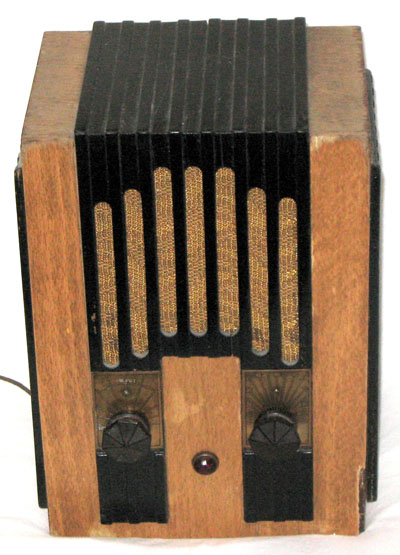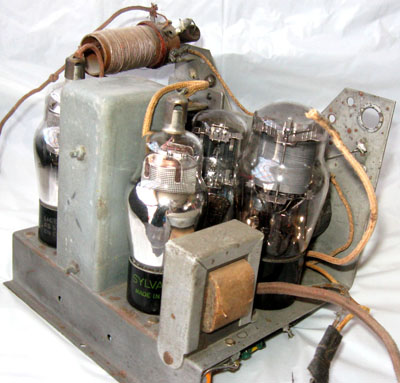Of Old Radios And Related Items--Published Monthly
My Halson NS-40 Becomes a Jefferson
BY RALPH JACKSON
Web Edition
Popular brand radios have appeared frequently in these pages, but once in a while we find that a relatively unknown one has become the focus of a collection. Ralph Jackson tells us about his discovery of Halson sets. (Editor)
I am a collector of antique radios, and, in particular, the Halson brand. Why this brand you ask? The reason is a purchase I made maybe eight or ten years ago. I had gone to a used furniture place in my hometown of Northborough, Massachusetts, and asked the owner if he had any old radios. He said no, but then he said to wait for him to look in his truck. He brought in this miniature tombstone which was in OK condition. He told me $15 would buy it. Sold! My next task was to find out what I had purchased, model, value, etc.
I had joined the New England Antique Radio Club (NEARC), so I brought it to a swap meet and went to some of the old timers like Wally Worth, Ray Bintliff, and Dave Crocker. They came up blank. After more looking, I found it on the cover of Mark Stein's book, Machine Age to Jet Age II! The set I have appeared to be similar to the Halson Jefferson, a blonde cabinet with black lacquer highlights. This same radio is shown twice in Stein III: as a Halson NS-40, an AC/DC set with a plain walnut case, and as a Remington D7778 with a dark cabinet and light-colored trim. I wonder who did the original design.
Stein lists the price of these sets from $350 to $450. Most likely my set is the plain Halson NS-40. Delighted, I decided to collect Halsons, and my count at present is 31 radios.
Figure 1. My restored Halson Jefferson Model NS-40.Since I like all my radios to work, I needed a schematic for the Model NS-40 and found one in Rider's Volume 4, dated 4/23/33 -- a year and a half before I was born. However, I still have not been successful in getting the set working, so this article is about a work in progress.
My NS-40 Becomes a Jefferson
When I got the radio, the case was all walnut color and devoid of any finish. That was one of the reasons I had trouble identifying it because it was not as striking as the blond with black lacquer Jefferson, as shown on the cover of Stein II. So my dilemma was what to do with the finish, and as you can see from my refinished set in Figure 1, I decided to change the NS-40 into a Jefferson.
First, I got some thin veneer and cut a pattern to fit the front of the case. I bleached the veneer and other flat surfaces with oxalic acid to get the blond color. The fluting on the four sides was treated with glossy black lacquer. I was quite new to collecting at that time and often wonder if I lowered the value by what I did. But my original set was so homely and blah that I am glad I made the change.
The front has a neat, red, jeweled "ON" indicator in the lower center just below the knob level, as seen in Figure 2 (see print version). The knobs are Bakelite and octagonal-shaped with a convex peak in the center and molded spokes. They are attached to the round shafts with a single set screw. I believe they are original.
Behind the volume knob on the left is a brass plate with a clockwise arrow and the word "Volume" above. The tuning knob on the right is backed by another brass plate calibrated 0 to 100 in about 180 degrees, typical for TRF designs.
Of course, because the set is not an original Jefferson, the plate at the front bottom center with the word "Jefferson" is missing. I replaced the grille cloth with a fairly plain gold color. There is supposed to be a wooden back with cutouts; it too is missing. The case is solid, and no gluing or other repair was necessary.
Circuit Description and Restoration
The radio is a TRF design and the tube lineup is Types 25Z5, 78, 77, 43. Fortunately, the chassis, shown in Figure 3, has no rust. It is secured to the case by one metal screw in the middle rear and the knobs on the front.
Fortunately, the voice coil is good. The cone moves freely and has a small rip that I will repair. I know cones can be replaced.
Unfortunately, the speaker has an open field winding. A very friendly mechanical design allowed for easy access to the field coil, so I took it apart to see if the break was where the small coil wire attaches to the much larger chassis wiring. Unfortunately, the break was not there. Figure 4 (see print version) shows the speaker with the field coil removed. I may get an estimate for repair of the coil, if there is someone who does that type of thing.
Figure 3. The chassis of the Halson NS-40.I have had that good fortune a couple of times, but no luck yet on this one.
At one time, I picked a wire size and calculated it would take around 18,000 turns to get the 2,830-ohm DC resistance. Assuming my calculations are correct, I know there is no way I could get that many turns neat enough to fit in the physical space available.
One of the cathodes of the Type 25Z5 rectifier tube is connected to a 4uf filter capacitor which is in parallel with the speaker field coil. The other side of both the speaker and capacitor is connected to ground (chassis). The other cathode feeds into an LC pi filter network with 10uf on the rectifier tube side and 4uf on the B+ side. The filter choke is on the right rear of the chassis and is good, having a 450-ohm DC resistance. I do not know the value of the inductance.
The volume control is a 200K-ohm potentiometer connected between the antenna and the cathode of the Type 78 RF amplifier. The arm of the potentiometer is grounded. The next tube in line is a Type 77, which functions as an amplifier/detector. The detection is biased by a 40K-ohm resistor in parallel with a 5uf capacitor in the cathode circuit. The grid of the Type 77 is connected to a tuned circuit.
The final stage is a Type 43 power amplifier with a resistor/capacitor bypass cathode circuit. The output transformer primary is shunted by a 0.02uf capacitor.
The resistance line cord of 175 ohms, is open. No surprise there. I have not decided how to replace that voltage drop which at 0.3 amps is about 53 volts. Of course, replacing the resistance line cord with a resistor results in an excessive 17-watt power dissipation in the resistor. I am aware of write-ups on alternate ways to achieve the series filament voltage drop in both A.R.C. (in March 2005, with a correction in May 2005) and www.Nostalgiaair.com.
The power cord resistor and filaments are all in series with the 2.5-volt pilot lamp which is rated for 0.5 amps according to the schematic. That means it is a #43 bulb, but the 0.5-amp bulb spec is more than the 0.3-amp filament draw. Maybe that is done on purpose to accommodate the cold filament surge, but the bulb will be dimmer than its rating. Not shown on the Rider schematic is a 25-ohm wire-wound resistor in parallel with the bulb, which maintains the filament circuit if the bulb fails.
I have replaced all the capacitors and most of the resistors. However, the restoration of my Halson radio is still ongoing. I'd appreciate hearing from a reader out there who might have some suggestions regarding my two remaining issues: the speaker field coil and replacing the resistance line cord.
Reference:
Rider, John F. Perpetual Trouble Shooter's Manual, Vol. IV, Halson page 4-3. New York: John F. Rider, Publisher, 1934.
After retiring from a 33-year career with Raytheon, Ralph Jackson, an electrical engineer, began collecting radios in 1998. His collection consists of about 100 mostly wooden radios from the 1930s to the 1940s. He traces his interest in radio to his U.S. Army training in vacuum-tube electronics in 1954.
|
[Free Sample] [Books, etc., For Sale] [Subscribe to A.R.C./Renew] [Classified Ads] [Auction Prices] [Event Calendar] [Links] [Home] [Issue Archives] [Book Reviews] [Subscription Information] [A.R.C. FAQ]URL = http://www.antiqueradio.com/Aug09_Jackson_Halson.html Copyright © 1996-2009 by John V. Terrey - For personal use only. Last revised: February 28, 2009. For Customer Assistance please contact ARC@antiqueradio.com or call (866) 371-0512 toll free Antique Radio Classified |

